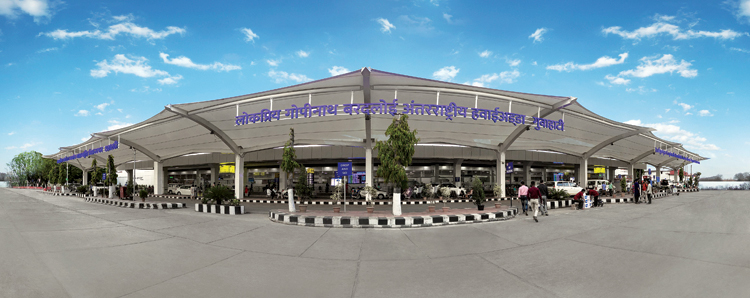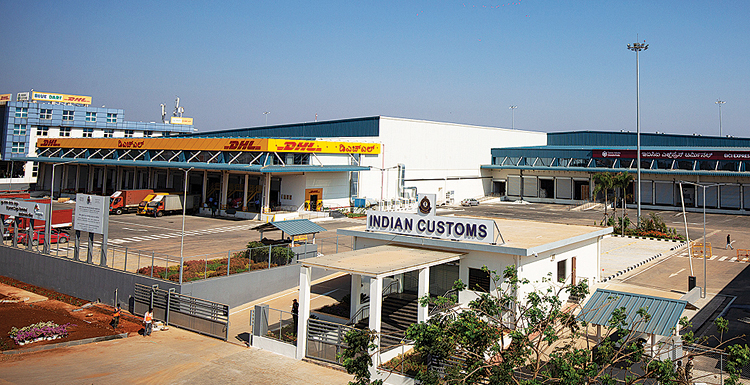INDIAN ARMED FORCES CHIEFS ON
OUR RELENTLESS AND FOCUSED PUBLISHING EFFORTS

SP Guide Publications puts forth a well compiled articulation of issues, pursuits and accomplishments of the Indian Army, over the years

I am confident that SP Guide Publications would continue to inform, inspire and influence.

My compliments to SP Guide Publications for informative and credible reportage on contemporary aerospace issues over the past six decades.
Vision 2040: Roadmap for India
Vision 2040 for the Indian aviation sector will improve the technical knowledge threshold of the nation and provide jobs to both technical and non-technical personnel

The Indian economy is the fastest growing economy in the world. This growth covers all sectors of trade and commerce including the aviation sector. The Indian government has realised the latent opportunities that lie in the growing aviation sector and has aspired to make India one of the best-performing aviation hubs by the year 2040. Accordingly, they have rolled out a roadmap titled Vision 2040 for the civil aviation sector.
The factors which have contributed to the emergence of this Vision include the rising disposable incomes and aspirations of Indians to travel by air. These travelers understand the value of time viz a viz money saved, to achieve more within the given time frame. Therefore, they prefer to travel by air than by road. Moreover, abundant technical manpower is available in India to carry out Maintenance Repair and Overhaul (MRO) of aircraft, big data analysis to make profitable flight itineraries, undertake aircraft designing and also develop financing models.
A statistical analysis of the existing aviation data has predicted that by the year 2040, the Indian aviation sector is likely to fly 110 crore passengers. This is a fourfold increase in passenger haulage compared to the pre-COVID-2019 figures. It is a well-known fact that there are close to 1,000 aircraft orders that are pending deliveries in India which have been staggered due to the pandemic. Consequently, the commercial fleet is likely to touch a figure of 2,359 aircraft by the year 2040. It will entail replacing older aircraft and the acquisition of new ones to enhance the capacity of airlines.

These aircraft may require about 200 airports to serve them. It will entail the construction of new airports, enhancing the capacity of the existing ones to serve this huge volume of passengers and aircraft traffic. In all probability, this prediction translates to an additional requirement of acquiring about 1,50,000 acres of land with a capital outlay of 3,375 crore.
The realisation of this vision is only possible if a well-articulated and coordinated roadmap for the development of the Indian aviation sector is laid out. This roadmap will then be amplified as a comprehensive blueprint which should be diligently implemented through a proper team of project managers, supported by project auditors who will gauge the benchmarked progress. In a nutshell, it can be said that this will constitute the new Nabh Nirman Scheme. This scheme will introduce paperless travel, also known as DG Yatra, Air Sewa for online passenger grievance redressal system being put in place, the rationalisation of Air Turbine Fuel (ATF) and MRO taxes, construction of new airports and the acquisition of the latest aircraft. Certain factors that need deliberation for the successful implementation of this vision are articulated below.
FINANCIAL ASPECTS
The capital budget requirement of 3,375 crore to realise this vision has to be raised within the next 18 years. An operations researchbased plan has to be made to identify the construction of infrastructure on priority which will start yielding revenues at the earliest. For example, the expansion of the existing Amritsar airport to make it a full-fledged international flight destination including the operation of Haj-related flights can be done on priority. This will fetch newer revenues as the comfort of landing at Amritsar for the diasporas and reaching home, within a few hours is going to be the biggest magnet that will attract the elderly, the young and sick passengers.
All these advancements in the aviation sector will generate their own revenues to fund further capital investments at the minimal possible opportunity cost
The above three categories of people presently avoid travel on account of the distance-related discomfort caused by the uncomfortable journey from the IGI Airport at New Delhi, to their residences in Punjab. In any case, the modern concept of airport siting is to locate them within the area from where the maximum number of passengers hail from. Similarly, an air cargo hub is to be near or within an industrial township where the air cargo is manufactured.
It can be seen l that New Delhi airport is only serving the residents of Delhi NCR. It is a cumbersome and expensive journey for travelers from Punjab, Himachal Pradesh, Uttarakhand and J&K to reach Delhi. Hence globally, a new concept is coming up wherein cargo movement airport hubs having no-frills are established at those places where the means of final production of air cargo are located. This moves out the air cargo in the least possible time and cost. Once revenues start streaming in from the revamped airports, they will be used to fund development of other airports. This will reduce the requirement of capital outlays well before the expiry of the projected gestation period of 18 years - the development time needed for the implementation of the Vision 2040 mission.
Similarly, airports at Guwahati and Kashmir can also be made into fullfledged international airports. In the case of the latter, rail connectivity from Udhampur to Kashmir is likely in the near future. This will reduce travel time and cost for passengers from the Jammu and Doda regions to reach the Kashmir international airport.
The aforesaid airport citing philosophy will decongest traffic from choked airports like Delhi. The above-mentioned airports proposed for upgradation, lie in the proximity of the homes of the diasporas. Their patronage will fetch quick revenues through airports that can be used to augment the capital outlay.

Another way to avoid cash outflow for the capital acquisition of land is by pooling farmlands and offering the owners automatic revenue-generating assets like shares in the hotels, retail shops at the airport, providing airside material handling equipment in lieu of land, jobs to their kith and kin within aerocities created so that they are willing to forego their land in exchange for remuneration and employment for their future generations.
All these advancements in the aviation sector will generate their own revenues to fund further capital investments at the minimal possible opportunity cost. However, this amount will not be sufficient to achieve the mission of Vision 2040. There will be a shortfall which will be made up by a capital grant from the government to the tune of about $2 billion through a special purpose vehicle called as the NabhNirman fund.
TECHNICAL ASPECTS
The Indian government needs to hand-hold the private sector in association with Hindustan Aeronautics Limited to capture a major share in the manufacture or assembly of aircraft within India. In addition, with so many aircraft flying in India, there is a robust opportunity for the creation of MRO infrastructure to repair both domestic and foreign-registered aircraft. The issue of taxation for MRO and ATF will also have to be rationalised and maybe make it lower than what Dubai and Singapore charge. The initial loss of revenue to the government due to lower taxation will be very easily made up through the increased number of domestic and foreign aircraft coming for refueling and repair into India.
VISION IMPLEMENTATION - THE WAY FORWARD
Now that Vision 2040 has been articulated, there is a requirement of making a special task force that will actually make the building blocks of the plan. This task force will require an inter-ministerial team to articulate the requirements expected on the ground. It should be headed by a secretary-level officer and have on board all stakeholders to include representatives from the state governments, central ministries, local municipalities, aviation sector representatives from the airlines, MRO and logistics companies. It will also have representatives from organisations that impart soft skills and technical training to aviation personnel. Aviation industry statisticians and operations research representatives have sufficient domain expertise and financial management skills including aircraft leasing and finance too need to be on board.
Once this team prepares the roadmap, it should be shared with the public and professionals to attract constructive criticism and analysis to improve upon it. This comprehensive roadmap is then converted into a project blueprint with implementation timelines. International participation may also be needed to make up for knowledge deficiency. The award of contracts has to be done timely and a robust arbitration process has to be introduced to minimise litigation-related disputes which delay projects.
All the stakeholders including the judiciary, arbitrators, financial experts, banking institutions, railways and NGOs will have to be co-opted in advance who should be able to facilitate the successful execution of this project in a time-bound manner. A monthly review of the progress at the highest level would be required to check for possible delays and set them right. Vision 2040 for the Indian aviation sector will improve the technical knowledge threshold of the nation and provide jobs to both technical and non-technical personnel. It will also spread economic prosperity in India’s hinterland and spur industrial growth leading to greater happiness.





